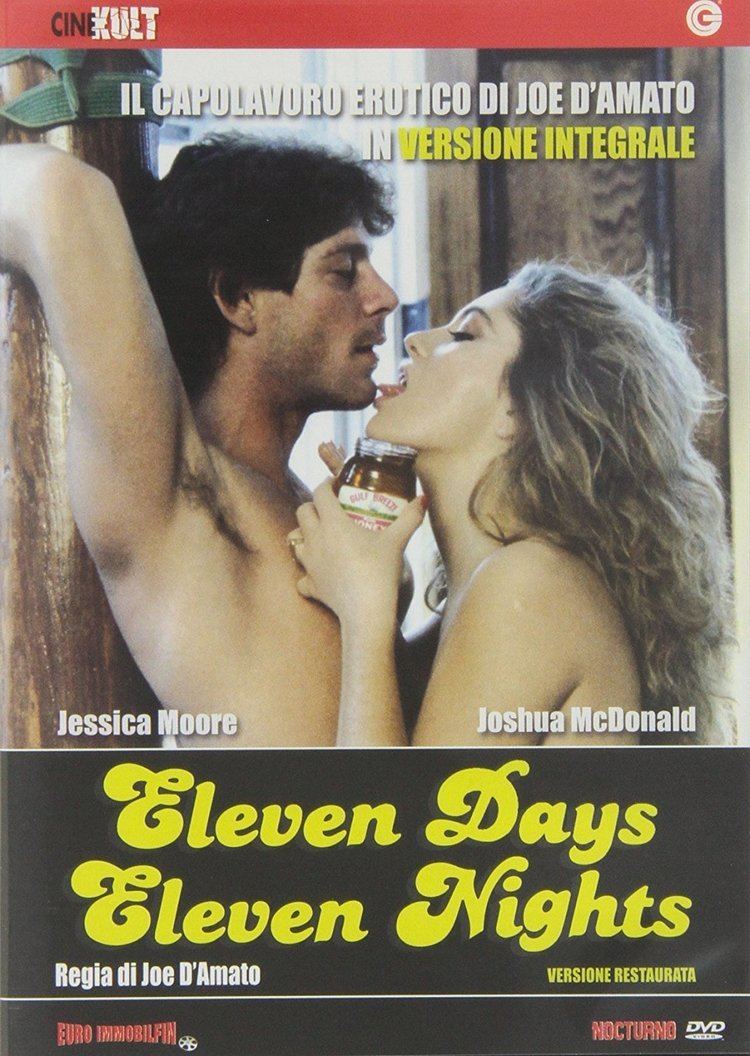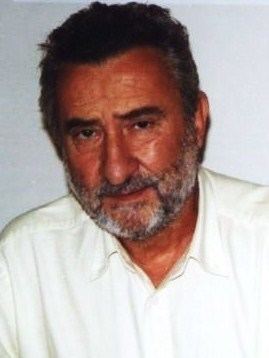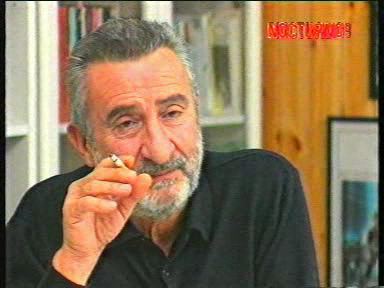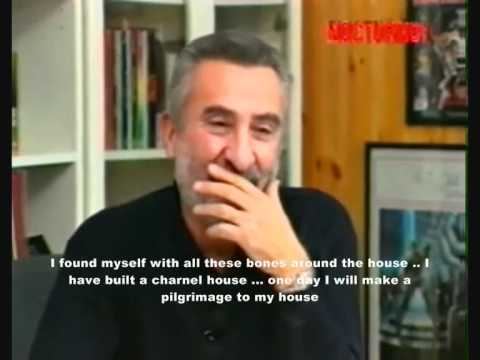Parents Renato Massaccesi | Years active 1961–1999 | |
 | ||
Full Name Aristide Massaccesi Spouse Carmela Massaccesi (m. ?–1999) Children Daniele Massaccesi, Francesca Massaccesi Movies Antropophagus, Beyond the Darkness, Erotic Nights of the Living, Caribbean Papaya, Emanuelle's Revenge Similar | ||
Joe D'Amato (birth name: Aristide Massaccesi; 15 December 1936 in Rome – 23 January 1999 in Rome) was an Italian filmmaker who directed roughly 200 films, usually whilst also serving as producer and cinematographer, and sometimes providing script-writing duties as well. While D'Amato contributed to many different genres (such as spaghetti westerns, horror, war movies, swashbucklers, peplums, and fantasy), the majority of his films are exploitation-themed pornography, both soft and hardcore. He also founded the influential Italian film production company Filmirage (the first film he produced was the 1980 Anthropophagous). He is generally considered the most prolific Italian filmmaker of all time.
Contents
- Biography
- Themes
- Attitude towards filmmaking
- Technique and methods
- DAmatos Caribbean film series
- The Aliases of Aristide Massaccesi
- Selected filmography
- Selected films as producer only
- References

D'Amato is perhaps most well known for his horror films, many of which went on to become cult movies (such as Anthropophagous, Death Smiles at a Murderer and Beyond the Darkness), and for his hastily produced remakes of popular American films (such as the Ator series, based upon the Conan the Barbarian films). D'Amato's remakes often incorporated elements of several popular films of disparate genres, in an attempt to reach the widest possible audience. In his later years, D'Amato was almost exclusively a director and producer of adult films, becoming one of the most renowned directors of pornography in Italy.

The Joe D'Amato Horror Festival, with the art direction of Paolo Ruffini, is held in Pietrasanta, in his honor.

Biography

D'Amato was familiar to the environment of cinema through his father who worked as a studio electrician at Cinecittà. After he graduated high school, he began working in the Italian film industry performing as an electrician, a photographer or even as a screenwriter. He began his career in 1961 as an assistant camera operator (often working under cinematographer Franco Villa). Then, starting with Pelle di Bandito in 1969, he regularly worked as director of photography for directors such as Demofilo Fidani (Dead Men Don't Make Shadows, One Damned Day at Dawn… Django Meets Sartana!, A Barrel Full of Dollars), Alberto De Martino, Massimo Dallamano (What Have You Done to Solange?), Silvio Amadio, Mino Guerrini, Umberto Lenzi (Paranoia) and Michele Lupo (Ben and Charlie). He was also assistant cameraman on What Have You Done to Solange?, The Killer Is on the Phone, The Devil's Wedding Night, and 1974's The Antichrist (film).

In 1972, D'Amato started directing his own movies whilst still continuing to work as cinematographer for other directors. His first directorial efforts include the Spaghetti Westerns Scansati... a Trinità arriva Eldorado and A Bounty Killer in Trinity, the decamerotic movies Novelle licenziose di vergini vogliose and More Sexy Canterbury Tales (The Last Decameron), the swashbuckler burlesque Fists, Pirates and Karate (starring Richard Harrison), the war movie Heroes in Hell (with Klaus Kinski), the sword and sandal movies The Arena (uncredited) and Livia, una vergine per l'impero romano (a.k.a. Diario di una vergine romana), the gothic giallo Death Smiles at a Murderer (starring Klaus Kinski and Ewa Aulin), and the western Cormack of the Mounties/ Giubbe Rosse (with Fabio Testi and Lionel Stander, shot in Canada alongside Lucio Fulci's movie The Return of White Fang (on which D'Amato worked as second unit director).
In the latter 1970s, D'Amato tried to capitalize on the worldwide commercial success of the French softcore movie series Emmanuelle. His first attempt, Emanuelle's Revenge (a collaboration with Bruno Mattei) only referred to the French heroine by name. The next movie, Black Cobra Woman (a.k.a. Eva Nera), starring Jack Palance and Laura Gemser, already incorporated several plot elements from the French series. Laura Gemser had previously impersonated the character of Black Emanuelle in a film by Bitto Albertini. Under the direction of D'Amato (who had first cast her as a maid in his 1976 erotic comedy Vow of Chastity, Gemser continued the series with a total of five sequels (Emanuelle in Bangkok (1976), Emanuelle in America (1977), Emanuelle Around the World (1977), Emanuelle and the Last Cannibals (1977), and Emanuelle and the White Slave Trade (1978)), a series which grew increasingly violent, including gang rape, zoophilia, cannibalism, and fake snuff film footage. (Some versions for the foreign market — especially in France — also contained hardcore sex scenes, which D'Amato claimed not to have directed himself.) Besides the Emanuelle movies, D'Amato also directed Ladies' Doctor (1977), a sexy satire on the Italian health care system starring Renzo Montagnani, the mercenary movie Tough to Kill (1978), made two erotic mondo movies (Emanuelle and the Erotic Nights and Sexy Night Report) again in collaboration with Bruno Mattei, and the sequel Sexy Night Report 2 on his own. At the end of the '70s, D'Amato directed The Pleasure Shop on 7th Avenue (which follows the Last House on the Left formula and, though essentially a softcore movie, contains in its uncut version, a brief scene of fellatio), and Images in a Convent (a nunsploitation movie containing a hardcore gang rape & fellatio scene).
In the early 1980s, D'Amato made some of his best known gore films such as Antropophagus (The Grim Reaper), Absurd (Rosso Sangue), and Buio Omega (Beyond the Darkness), for which he later gained cult status among horror film fans. Some of his most utilized actors were Laura Gemser, Luigi Montefiori, Donald O'Brien and Gabriele Tinti.
He then went into an early hardcore phase, starting out with a series of hard and soft porn movies shot around Santo Domingo in the Dominican Republic. Some mix eroticism with horror movie themes like cannibalism (Papaya, Love Goddess of the Cannibals, softcore, with Sirpa Lane), zombies (Erotic Nights of the Living Dead, hardcore, with Laura Gemser), voodoo Sex and Black Magic (a softcore movie starring Richard Harrison), and homicidal radioactive mutants (Porno Holocaust, hardcore). Less horrific are Black Sex (the first genuine Italian hardcore movie) and at the same time a weird melange of ghost story and cancer drama), Hard Sensation (another variation on the Last House on the Left model, also hardcore) and Paradiso Blu (a softcore Robinsonade starring Anna Bergman). Recurring stars of these movies were Mark Shannon, Lucia Ramirez, Dirce Funari, and Annj Goren.
Back in Italy, D'Amato mostly worked together with Claudio Bernabei on a number of obscure low-budget hardcore productions with titles like Super Hard Core, La voglia, Blue Erotic Climax, Le porno investigatrici, Stretta e Bagnata, Bocca Golosa, and Love in Hong Kong, for most of which they used the directorial pseudonym Alexandre Borsky. On his own, D'Amato directed the so-called Imperial trilogy, starting with Caligula: The Untold Story (the sequel to Tinto Brass's Caligula) and concluding with the obscure low-budget follow-ups Messalina Orgasmo imperiale and Una vergine per l'impero romano. Recurring stars of this period were Pauline Teutscher, Laura Levi, Mark Shannon (again), and Paolo Gramignano.
Around this time, D'Amato also started working as a producer, which eventually led to the founding of his own film company. From 1982 to 1994, Filmirage — as it was called — financed a total of 42 escapist non-hardcore genre entries: slashers, horror, and post-apocalyptic movies directed by Umberto Lenzi (La Casa 3 - Ghosthouse, Hitcher in the Dark), Claudio Fragasso (La Casa 5, Troll 2), Lucio Fulci (his last movie: Door into Silence), Michele Soavi (directorial debut: Stage Fright), and Luigi Montefiori (2020 Texas Gladiators), as well as a number of horror, fantasy, and softcore erotic movies directed by D'Amato himself, most notably three of the four Ator movies, the postapocalyptic film Endgame, the Dirty Dancing rip-off Dancing Is My Life (starring Valentine Demy), and the trilogy revolving around the fictional author Sarah Asproon (Eleven Days, Eleven Nights, Top Model, and Web of Desire, starring Jessica Moore and Kristine Rose). Cinzia Monreale (co-star of Buio Omega) came back to star in his mid-90s film Return From Death (Frankenstein 2000), one of D'Amato's last horror films.
In 1994, when Italian cinema was at a low point commercially, D'Amato returned to hardcore filmmaking. For his first handful of low-budget productions (mostly starring Luana Borgia), he again used the pseudonym Alexandre Borsky — before teaming up with Luca Damiano to co-direct, mostly uncredited, a number of higher-budgeted costume porn movies such as Aladdin X, Marco Polo, and Hamlet X.
Then, from 1995 until his death in early 1999, he mostly directed and produced movies on his own again, founding the production companies Butterfly Motion Pictures and Capital Film (with seat in Los Angeles). He transformed into hardcore pornography such diverse subject matter as the tragedies of William Shakespeare (Juliet & Romeo, Othello 2000, Anthony and Cleopatra), Greco-Roman mythology (Ulysses, Samson and Hercules in the Land of the Amazons, Olympus - Refuge of the Gods), Roman emperors (Caligula - The Devious Emperor, Nero, Messalina), the 1920s and 1930s in the U.S. (Gangland Bangers, Some Like It Hard, Rudy - The Valentino Story), the W.I.P. genre (Operation Sex, The Joy Club, Midnight Obsession), the western (Outlaws, Calamity Jane), and Swashbucklers (Selen the Girl from Treasure Island, Raiders, Lady in the Iron Mask). He also devised porn versions of successful movies, such as Anal Instinct (Basic Instinct), Dangerous (Damage), Eternal Desire (Highlander), Anal Paprika (Paprika), Robin Hood: Thief of Wives (Robin Hood: Men in Tights), and Anal Perversions of Lolita (Lolita).
D'Amato was one of the few porn directors who in the late 1990s continued to shoot on 35mm film (and not on video). In the last five years of his life, he directed almost 100 hardcore movies for the European video market. During this time, he also sought ways to finance non-hardcore movies with money earned from directing hardcore pornography, of which he grew tired at times. They were to be four: the erotic movies Provocation (1995) and Top Girl (1996), the erotic thriller The Hyena (1997), and the pirate adventure movie I predatori delle Antille (1998) starring Anita Rinaldi.
Shortly after completing the hardcore feature Showgirl, Joe D'Amato died of heart failure at his villa in Rome on Jan. 23, 1999.
He had one son, Daniele Massaccesi, who started out by helping his father in the camera department and later moved to the United States where he entered into a lucrative career as a cameraman, working on such films as Cold Mountain, Hannibal, and Kingdom of Heaven.
Themes
D'Amato built many of his filmography's plots around strong female characters with a promiscuous tendency. A recurring theme in his movies is on-screen voyeurism scenarios, in which either a man or a woman watches a sexual act from a hiding place, often leading to sexual arousal and self-masturbation.
Until 1994, D'Amato's horror movies also contained graphic gore scenes, many of a cannibalistic nature. Most notorious in this respect are D'Amato's movies Antropophagus, in which the monstrous protagonist devours a human fetus ripped from the womb of one of his victims and at the end of the movie gnaws on his own entrails, and Buio Omega, in which the protagonist bites into a human heart, but the theme already occurs in one of D'Amato's earlier films, Emanuelle e Françoise le sorelline (1975), which was an erotic thriller fantastique with a cannibalistic dinner scene. Besides that, cannibalism is only marginally present in Ator 2: The Blade Master and Endgame.
Emanuelle in America unexpectedly contains fake, but gritty, snuff film footage.
Attitude towards filmmaking
People who worked with D'Amato have repeatedly stated in interviews that he was a very kind man, on and off set.
D'Amato himself repeatedly said that he really enjoyed filmmaking, but that he was sometimes more concerned with making money than any kind of artistic merit his films might have had. His attitude could perhaps best be characterized with a line from his film Emanuelle's Revenge, spoken by a film producer playing a facsimile of D'Amato: "We're not making artsy-fartsy crap for intellectual faggots. We're out to make money!".
Circa 1998, shortly before his death, D'Amato flew to New Jersey to appear as a guest at the Chiller Theatre Horror Convention, where he was treated like royalty. Upon his return to Italy, he told all of his friends and associates how his American fans were lining up by the hundreds, each paying him $10.00 for an autographed photo of himself. He commented that it was idiotic for them to waste their money like this, and said he couldn't understand their adoration. Apparently, he didn't realize how many fans he had outside of his native country.
Technique and methods
D'Amato is renowned for having produced and directed many "knockoff" films - a common practice in the Italian film industry at the time - which D'Amato took to extremes, e.g. in the following cases:
D'Amatos "Caribbean film series"
D'Amato filmed PAPAYA OF THE CARIBBEAN in 1978 in the Caribbean, and got the idea to shoot 5 more films there in 1980. D'Amato took George Eastman and some of his regular cast members and crew back to the Caribbean, where they took advantage of the exotic locales to film five more movies back to back. The films share the same beach and jungle sets, as well as feature the same cast members from film to film. The 5 films were: ORGASMO NERO, HARD SENSATIONS, BLACK SEX, EROTIC NIGHTS OF THE LIVING DEAD and PORNO HOLOCAUST. The films were made very cheaply, since they shared the same locations and actors.
The Aliases of Aristide Massaccesi
D'Amato always took credit for his camerawork with his birth name Aristide Massaccesi until his late hardcore phase, when he started to use the pseudonym Frederiko Slonisko.
When first starting to work as a director, he chose to credit the producer or co-director instead because he wanted to avoid interference between his directorial work, of which he did not think much due to budget constraints, and his professional reputation as cinematographer. Around 1973, he started using directorial pseudonyms, the first being Michael Wotruba. The only movie which D'Amato as a director ever took credit for with his birth name was to be Death Smiles at a Murderer (1973); in an interview, D'Amato said he had felt comfortable with the reasonably high budget and the actors he had at his disposal.
In 1974, he first used the name Joe D'Amato as director on the Canadian spaghetti western Cormack of the Mounties, a name proposed by producer Ermanno Donati to resemble the names of Italian American directors such as Martin Scorsese and Brian De Palma and which became his better-known pseudonym.
During his lifetime, D'Amato worked under innumerable aliases. Because of this, it is on the one hand possible that there are still Joe D'Amato films which are in circulation, which he wrote or directed, but for which he used an as yet unattributed pseudonym. This seems especially likely for the years devoted to the production of hardcore pornography in the early 1980s and the second half of the 1990s. On the other hand, titles are easily wrongly attributed to D'Amato as long as they are directed by a lesser known director with only one or a few titles in his oeuvre who happened to work in the same genre as D'Amato and whose name is then misinterpreted as a pseudonym of Joe D'Amato. This is largely due to the lack of easily accessible documentation on most of these movies.
The following is a list of pseudonyms D'Amato is known to have used. The names which recur on a regular basis are highlighted in bold.
Anna Bergman, Raf Donato, Gerry Lively, and Romano Gastaldi are sometimes listed under pseudonyms as well. However, these were not mere names, but actual people involved in the production of the respective movies who for various reasons took the credit in D'Amato's stead, and thus should not be listed as pseudonyms, but allonyms. The same goes for D'Amato's use of the fictitious character-name Sarah Asproon. Contrary to popular belief, John Shadow is not a pseudonym for Massaccesi, but the real name of a British filmmaker once married to Ewa Aulin.
